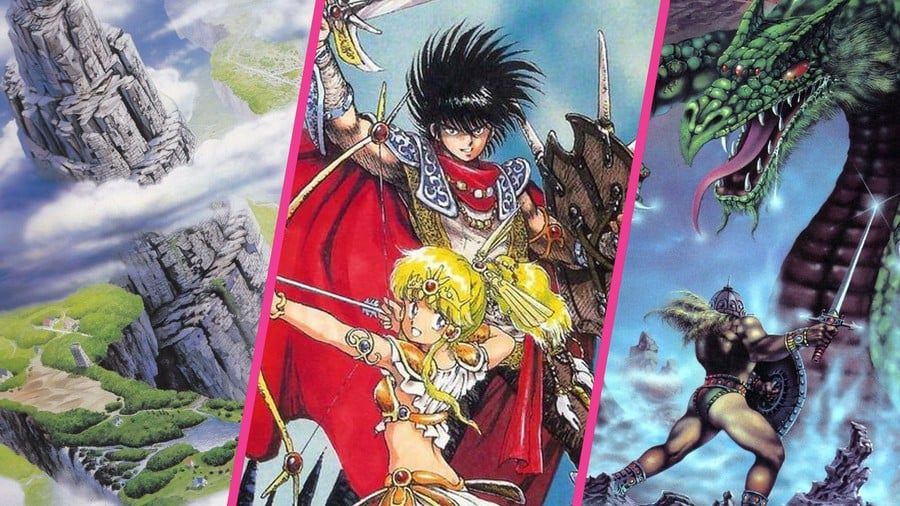
As part of our end-of-year celebrations, we're digging into the archives to pick out some of the best Time Extension content from the past year. You can check out our other republished content here. Enjoy!
It's fun trying to ascertain the precise origin of genres. No matter which game popularised a concept, with enough digging and creativity you can probably find an earlier precedent. For survival horror, surely Pac-Man and Haunted House could qualify as progenitors? It's the same with action adventures and The Legend of Zelda, released on 21st February, 1986. We just have to comb through everything before that day... right?
This genre sphere is extremely complex, originating alongside and overlapping traditional turn-based RPGs. That classification at least is easy. In Japan, you have two distinct eras: experimental RPGs before Dragon Quest, and everything which came after Dragon Quest. But when the combat aspect is real-time, the scope expands exponentially, leading to many fringe examples. For example, to what extent should you include 2D side-scrollers? Could Namco's Dragon Buster be considered part of the evolutionary tree which led to Symphony of the Night? Some say that Zelda isn't even a "true" action-RPG. So let's focus on games that, as much as possible, resemble it.
Partway through making it I kind of changed my mind, and it came out differently to what I intended. President Kato came up with the title; there's not much relation to Dragon Slayer
If you trawl Japanese archives for pre-1986 games you can build a list which, to varying degrees, fit the templates of The Legend of Zelda and its sequel The Adventure of Link (January 1987). Some are obvious and achieved success, such as Märchen Veil, while others are so obscure even aficionados in Japan won't recognise them. However, amidst this 'Precambrian Explosion' of invention, there stand two titanic software houses, each with its own celebrity auteur. Nihon Falcom with Yoshio Kiya, and T&E Soft with Tokihiro Naito, less known outside Japan but with a significant legacy.
Kiya and Naito are two coding bards with a rivalry that lasts to this day. If you want to understand the context of early Japanese games without getting sidetracked too much, these two are a good starting point.
Tangential genre examples started forming in Japan circa 1982, and in 1983 Kiya's Panorama-Toh was released - a bizarre hybrid of first-person dungeons, ASCII shopkeepers, and real-time overworld combat against lions, tanks, and... Nessie? Coded mainly in BASIC with some Assembly, it was a rough gem, which some regard as a spiritual 'Dragon Slayer Zero'. In actual fact, it started as a sequel to Falcom's first game, Galactic Wars. "Partway through making it I kind of changed my mind," says Kiya, "and it came out differently to what I intended. President Kato came up with the title; there's not much relation to Dragon Slayer. <laughs>"
From June 1984 everything exploded, starting with the arcade release of The Tower of Druaga, and Q4 seeing three prominent releases across multiple computer formats: Kiya's Dragon Slayer; Naito's Hydlide; and the obscure Courageous Perseus, by Cosmos Computer. What's interesting is the influence of Namco's Masanobu Endou during those nascent days, even if indirectly. As Kiya explains, "I saw Kazurou Morita's Alphos and realised you can actually make scrolling games on the PC-8801!" (Alphos was an officially licensed clone of Endou's Xevious, regarded as 'genius code' and doing things thought impossible on early computers.) "I decided if Morita can do it, then I should be able to. That's exactly how I came to make Dragon Slayer."
Endou also influenced Naito, who explains Hydlide's origins, "It just came to me. <laughs> At the time, I was in love with The Black Onyx and Namco's The Tower of Druaga. So Hydlide was roughly inspired by those. I liked action games, but I also liked role-playing games, so I tried to mix them together."
Without a doubt the greatest crisis for Hydlide was when Naito-kun saw the advert for Courageous Perseus! His face turned a sickly colour, like the whole world was coming to an end
Courageous Perseus predates Hydlide and possibly also Dragon Slayer, but never saw the same sales or sequels. It did however motivate others, as Naito's colleague Yasuo Yoshikawa explains. "Without a doubt the greatest crisis for Hydlide was when Naito-kun saw the advert for Courageous Perseus! His face turned a sickly colour, like the whole world was coming to an end. He picked himself up, but at the time we felt we were in trouble."
To which Naito adds, "The blended graphics looked excellent, and the concept looked nearly identical to an action-RPG. I remember being shocked. Later, I saw the actual game, and was relieved to discover it went in a different direction to Hydlide. Courageous Perseus was closer to an RPG, whereas Hydlide was closer to an action game. They were actually quite different."
Hydlide sold phenomenally well. "By 1986," Naito reveals, "console games outsold computer games significantly. The Famicom version alone sold a million copies, whereas the combined sales for all computer platforms also reached one million. In Japan when a successful music artist sells a million copies, Toshiba EMI gives you a plaque to commemorate [it]. We received one for Hydlide, which may have been the only computer game to receive one."
"I didn't care about how much my game sold, or if it sold at all," recalls Kiya. "At the time I didn't have any specific ideas. Nowadays you start with a concept and decide how to make the game, what to put in it. But at the time I didn't even know that was the way to make games! So up until Dragon Slayer I just started programming and whatever I happened to think of I stuck in, mixing in a whole bunch of things I thought would be cool."
"Dragon Slayer was designed to draw the background in the VRAM1 plane and characters in the VRAM2 plane," says Naito. "It was cheap-looking compared to Hydlide; I didn't feel threatened by it. Later, however, the programmer Kiya-san himself became a threat! <laughs> Kiya-san is a genius; I'm just an ordinary guy. Back then, I just happened to come out on top among ordinary people."
Up until then the way disks were used was just wrong; people were also still using cassette tapes! I wanted to show: this is how disks should be used, this is how much better the hardware is
Dragon Slayer was important, but Kiya's best-selling 1985 sequel Xanadu was revolutionary. "Everything up to Xanadu wasn't really a game, and everything from there is when games really started to take shape. At the time no one knew what a game was and everyone just kind of went along and figured it out," says Kiya. "Up until then the way disks were used was just wrong; people were also still using cassette tapes! I wanted to show: this is how disks should be used, this is how much better the hardware is. It was also really hard making games where there's lots of movement. So I thought about how to make fun games where you could move around a lot. Also with Xanadu, there was great variety in the number of characters. People were surprised, so afterwards Falcom focused on bigger numbers. From then on, Japanese computer games really did change."
Naito shares a similar view on the action-RPG genre's maturation. "Japanese people didn't have a well-defined sense of the RPG. I suspect that because of this, creators took the appearance and atmosphere of the RPG as a basic reference, and constructed new types of games according to their own individual sensibilities. In my case, I was inspired by Advanced Dungeons & Dragons and fairy illustrations in books from the West, and developed my own idiosyncratic view of the genre."
Naito was also heavily influenced by Star Wars. For his Hydlide sequel, released 1985, there was a "Force" bar, Jedi-style training, and black crystals which stopped HP regeneration, as if being corrupted by the Dark Side. "I was a big fan of Star Wars. That sequence when the wings open on the X-Wing, that scene still gives me a thrill today."

Unbeknownst to either developer, some of their influences eerily reflect one another. As Kiya revealed, "One thing that became a big influence was at the time I bought some Advanced Dungeons & Dragons books, read through them, and later started creating Xanadu with the ideas I got. Also at Falcom there was a book called Dictionary of Imaginary Places by Albert Manguel, and it was basically an encyclopaedia with medieval European stories. We read all through that and got ideas. When we developed a game, we decided the kind we wanted to make, the basic concept, and then we flipped through and arbitrarily decided: We'll use this story." Astonishingly, this single book influenced Falcom's creation of the Ys series!
Releases of Zelda-esque games continued, and January 1986 gave us Kazurou Morita's Riglas, featuring full-colour graphics and horizontal scrolling. A month later Shigeru Miyamoto's classic elf-boy adventure finally came out, thus ending our game of 'catch the precedent', while subsequent years saw an expanding roster of similar titles.
Understanding games which predate Zelda, despite many of them being nigh unplayable today, highlights the Zelda series' greatest strength: easy accessibility without compromising depth. The original Zelda might lack the scrolling of Dragon Slayer or Riglas, but it presented a challenging quest in a way that was inviting. Of course, focusing on Kiya and Naito for early action-RPGs is akin to saying only Nintendo and Sega made 16-bit games. There's an enormous back-catalogue of Japanese games, especially the role-playing variety. It's worth donning a sword & shield and exploring them.
